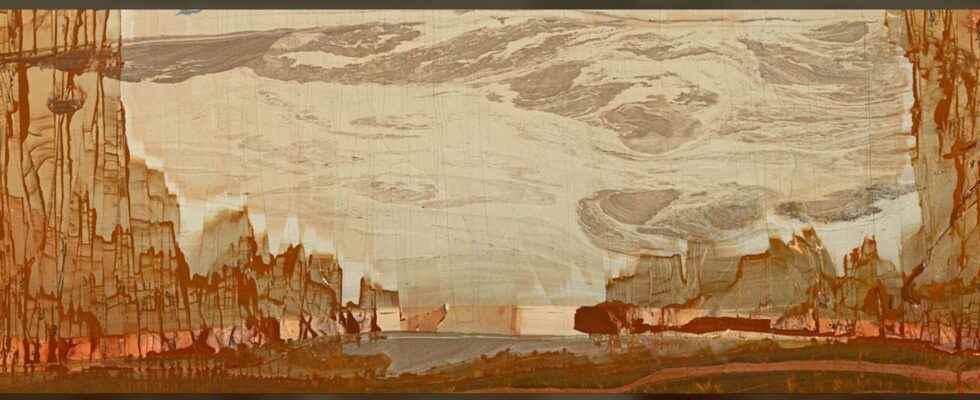In this new chapter of Cabinet of curiosities, let’s go to Italy to discover a stone that will sparkle your imagination. Today we are talking about the paesina, a rock formed over millions of years but hiding within it almost futuristic landscapes. Put on your glasses, open your mind to travel, and let’s go!
You will also be interested
[EN VIDÉO] Travel to Turkmenistan to discover its geological treasures In this trip to an unknown country with a particular geology, our guide is at ease: it is Jacques-Marie Bardintzeff, volcanologist, chronicler in Futura and man in the field. Turkmenistan offers magnificent landscapes to those who can read them.
At the edge of a lake, an imposing mountain overlooks a Gothic castle. On the other side of the world, a light blue sea fringed with foam emerges between the walls of a cave color of fire. A few kilometers away, a meteorite is caught in its fall, moments before it crashes off a majestic Atlantean city. And above the skyscrapers of a nameless metropolis, a mysterious and nebula haunts the sky. Each paesin is a new landscape that is revealed to eyes dreamers and curious, a stone with a ruiniform appearance that has been able to fascinate over time Pliny the Elder, the Medici family and Pablo Neruda.
Formed in the crucible of the vanished oceans
Paesin is not a mineral like any other. Also called landscape stone or marble ruin in English, this metamorphic rock is the result of 50 million years of geological transformations, an ancient and obscure alchemy of which only nature has the secret. Its backdrop arises from the intense compression of the sedimentary layers of limestone and D’clay appeared in the ocean floors of the Eocene. The patterns that distinguish this stone-landscape are for their part the result of infiltration of oxides and hydroxides of iron and of manganese in rock – before or after it has been fractured, this remains a mystery to researchers.
The paesin is also an elusive stone. Rare, it is found almost only in Italy – in Tuscany, in the Lazio region and in the Apennines. Its discovery is generally the fruit of a long research process, and of a lot of luck. Discreet, it does not reveal its singular appearance until the stone has been split in two, as a banal black stone would secretly contain an amethyst heart. Polymorphic, there are all kinds: from Verde d’Arno with geometric patterns, to organic Terra Bruciata di Rimaggio, which has become extremely rare these days. But it is the stones extracted from the Florentine mountains that still captivate aesthetes today, characterized by the landscapes in which so many imaginations have been projected.
The stone of artists and dreamers
If Pliny the Elder already described us in his Natural History the enthusiasm aroused by the extraction of the first paesins in the quarries of Chio, it was during the Renaissance, with the discovery of the Florence vein that this rock established its reputation. She is becoming a favorite of natural curiosity cabinets. Artists, painters and marquetrymen delight in these stone landscapes that they invest with fictitious characters or cut out to integrate them into complex works using the technique of ” commesso fiorentino ” (a kind of marquetry hard stones also known as the “Florentine mosaic” which I strongly encourage you to explore in more detail here).
Obviously a follower of mineralogy, the Grand Duke Ferdinand Ier de Médicis will institute the Office of the hard stone in 1588 and will carry a very particular affection to the paesine. He and his family will order and collect a vast set of objects and works incorporating this unique stone and will participate in its success in Europe, especially with Cardinals Richelieu and Mazarin. Whether or not they are the fruit of pareidolia, the scenes that draw us to the heart of this rock have captivated minds through the centuries, including that of Pablo Neruda, who will dedicate a poem to it. The paesine, window on unknown worlds, deserves, I hope I have convinced you, its place in our Cabinet of curiosities.
—
Discover Science Hunters ! Every other Saturday, immerse yourself in an immersion alongside the adventurers and researchers, the patients and the heroines who have written the small and the great History of science.
—
Interested in what you just read?
.
fs11
